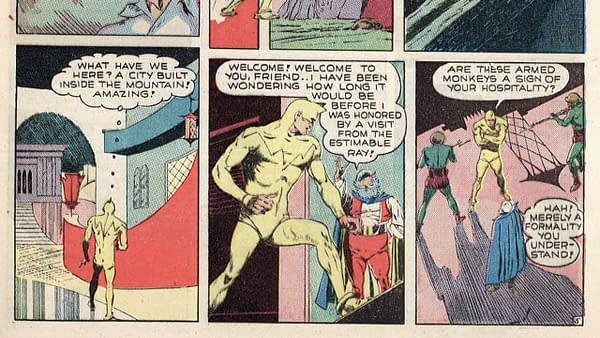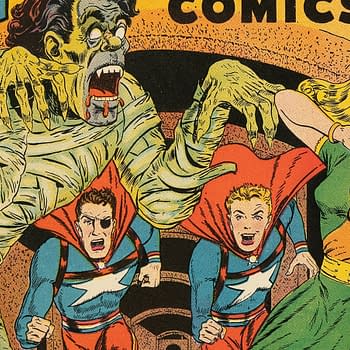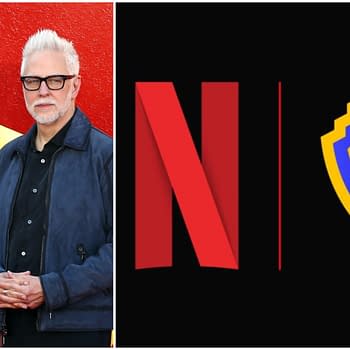Posted in: Comics, Heritage Sponsored, Vintage Paper | Tagged: lou fine, the ray
Lou Fine's The Ray and Other Smash Comics, Up for Auction
The Ray's early Golden Age adventures in Quality's Smash Comics were beautifully drawn by legendary comic book artist Lou Fine.
Article Summary
- Smash Comics features Lou Fine's iconic art on The Ray.
- The Ray's origins are linked to 1930s stratosphere balloon cosmic ray studies.
- Golden Age Smash Comics also has contributions from revered artists like Jack Cole.
The second title launched by Everett M. "Busy" Arnold's Quality Comics, Smash Comics started out as an anthology featuring a fairly typical if well-executed mix of pulp-inspired adventure heroes and humor. But by issue #14, the superhero character The Ray was introduced in stories beautifully drawn by legendary artist Lou Fine. The character began to get periodic cover-features in the title by the next issue, and remains well-remembered Golden Age superhero to the present day. Early appearances by an enduring superhero character with gorgeous Lou Fine artwork, there's a Smash Comics #21 (Quality, 1941) CGC FN- 5.5 Slightly brittle pages, his first cover appearance in Smash Comics #15, plus several other issues of the title up for auction in the 2024 May 30 Adventures in the Golden Age Comics Showcase Auction #40261 at Heritage Auctions.

In addition to the stunningly drawn The Ray story, Smash Comics #21 also features a story featuring the character Midnight by Jack Cole of Plastic Man fame, The Purple Trio by Alex Blum (who became known for work on Sheena and Jungle Comics for Fiction House), Invisible Justice by Art Pinajian, Magno the Magnetic Man by Paul Gustavson, and Bozo the Robot by George Brenner (creator of The Clock). Interestingly, this was the last Golden Age appearance of this version of Magno the Magnetic Man, likely because Ace Periodicals debuted in Super-Mystery Comics #1. two months before the first appearance of the Quality Comics version. In an interesting twist, this version of Magno appeared in DC Comics' All-Star Squadron #31 (March 1984) and died the next issue. DC Comics had acquired many of the Quality Comics characters after the demise of that company in 1956.
In the Ray's origin moment during his introduction in Smash Comics #14, reporter Happy Terrill embarks on a trip in an experimental "strato-balloon" which soars into the stratosphere and similarly to the Fantastic Four over 20 years later, gets caught up in a "cosmic storm." Bathed in the cosmic rays, Terrill is transformed into a figure who can "transmit himself in shafts of light." The strato-balloon experimental flight was clearly inspired by a number of manned stratosphere balloon flights of the 1930s such as those undertaken by Explorer I and Explorer II, which were conducted in 1934 and 1935 by the U.S. Army. At this time, such stratosphere balloons were the best way to study cosmic rays. In fact, Exporer II, which set an altitude record and was highly publicized at that time, included an experiment to specifically study whether cosmic rays might cause mutations in living organisms:
Medical scientists also used Explorer II to see what effect cosmic radiation might have on living organisms by sending Drosophila fruit flies aloft. Although they were carried inside the gondola, all of the adult flies in the package died due to the cold temperatures encountered during the flight. At first, the scientists feared the experiment would be a total loss, then they found some of the larvae and eggs survived and they ended up with 98 individuals for breeding. Subsequent results were inconclusive for any radiation-induced mutations due to the small number of flies returned.
With relatively modest census entries on the CGC Census, several of these are not easy to get. But there's a Smash Comics #21 (Quality, 1941) CGC FN- 5.5 Slightly brittle pages, his first cover appearance in Smash Comics #15, plus several other issues of the title up for auction in the 2024 May 30 Adventures in the Golden Age Comics Showcase Auction #40261 at Heritage Auctions.
















